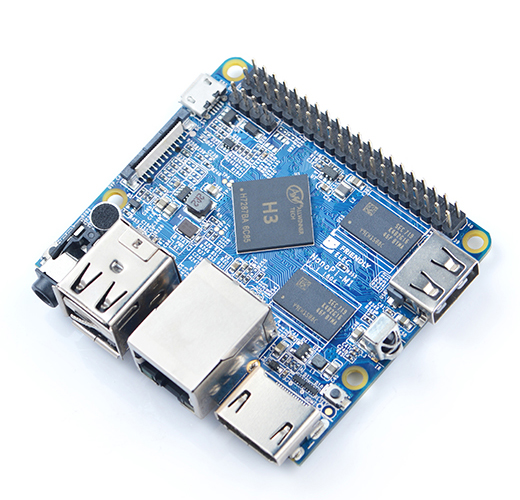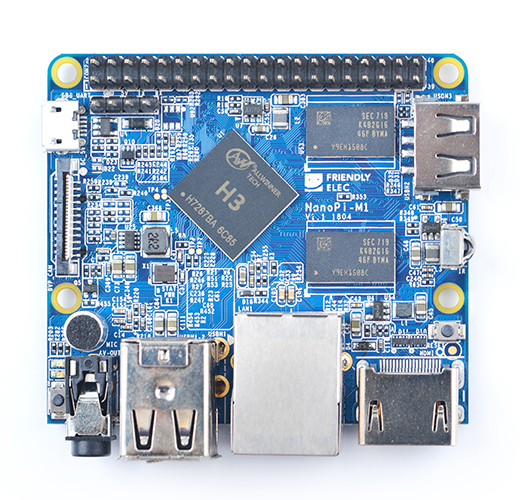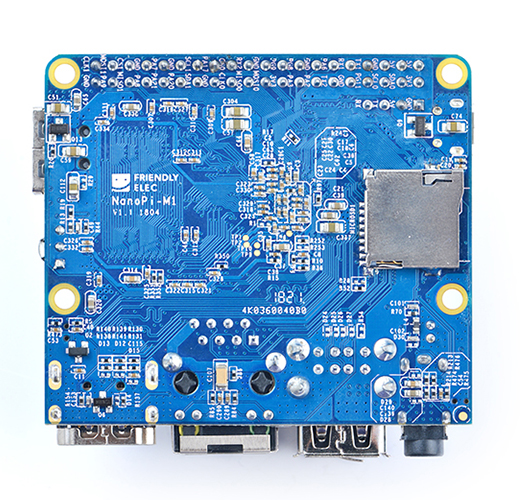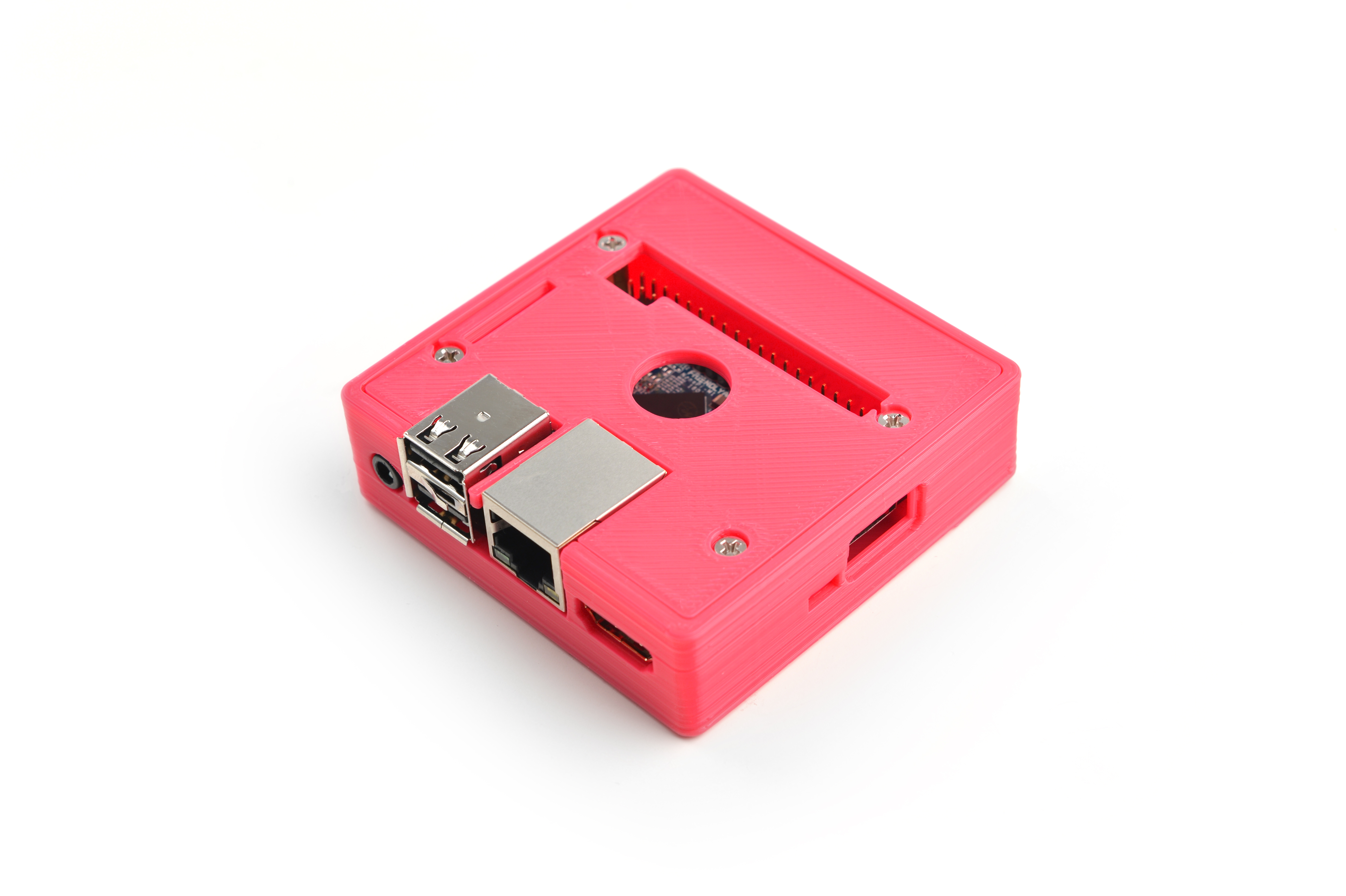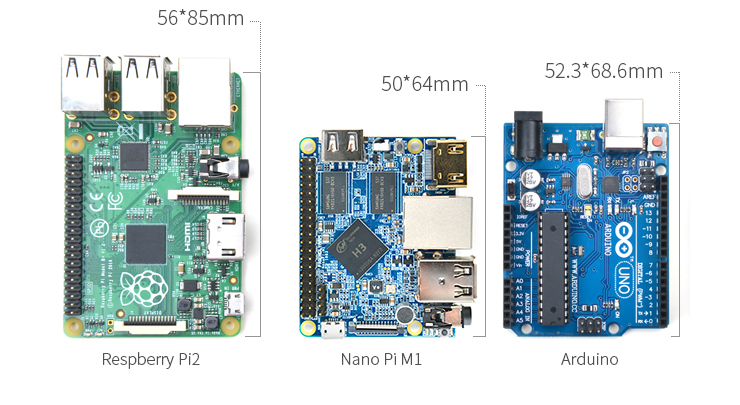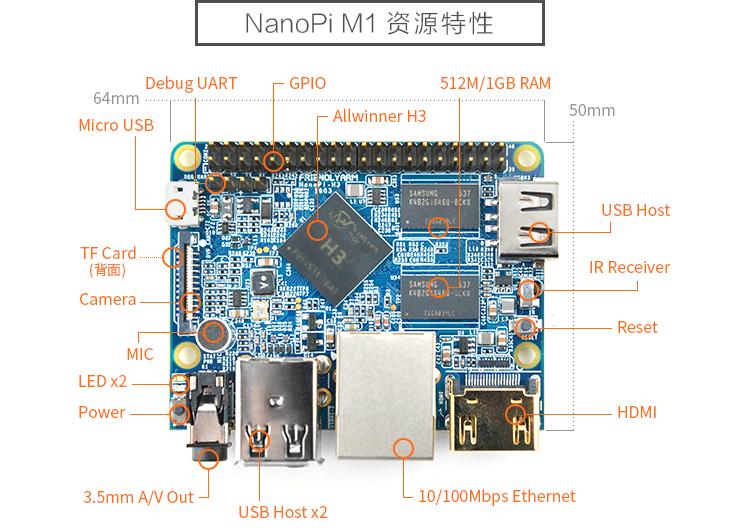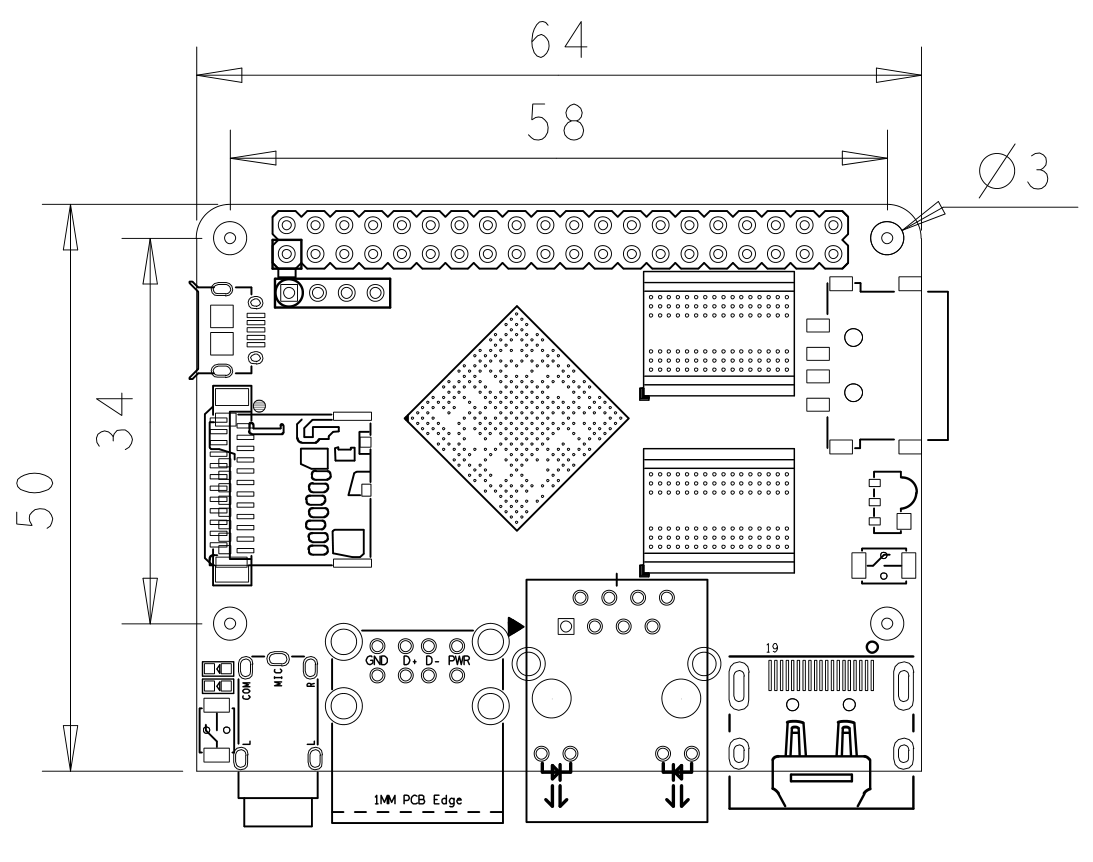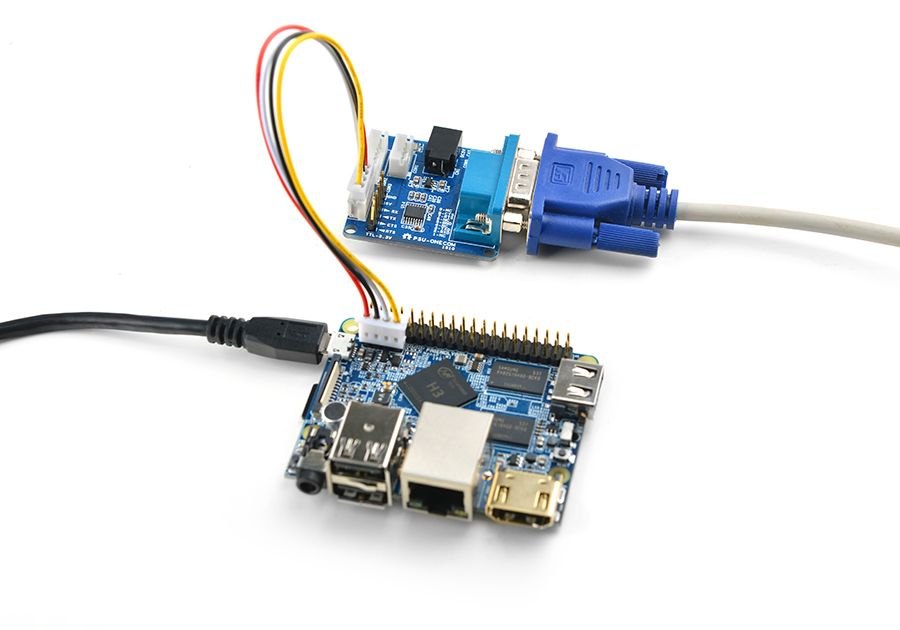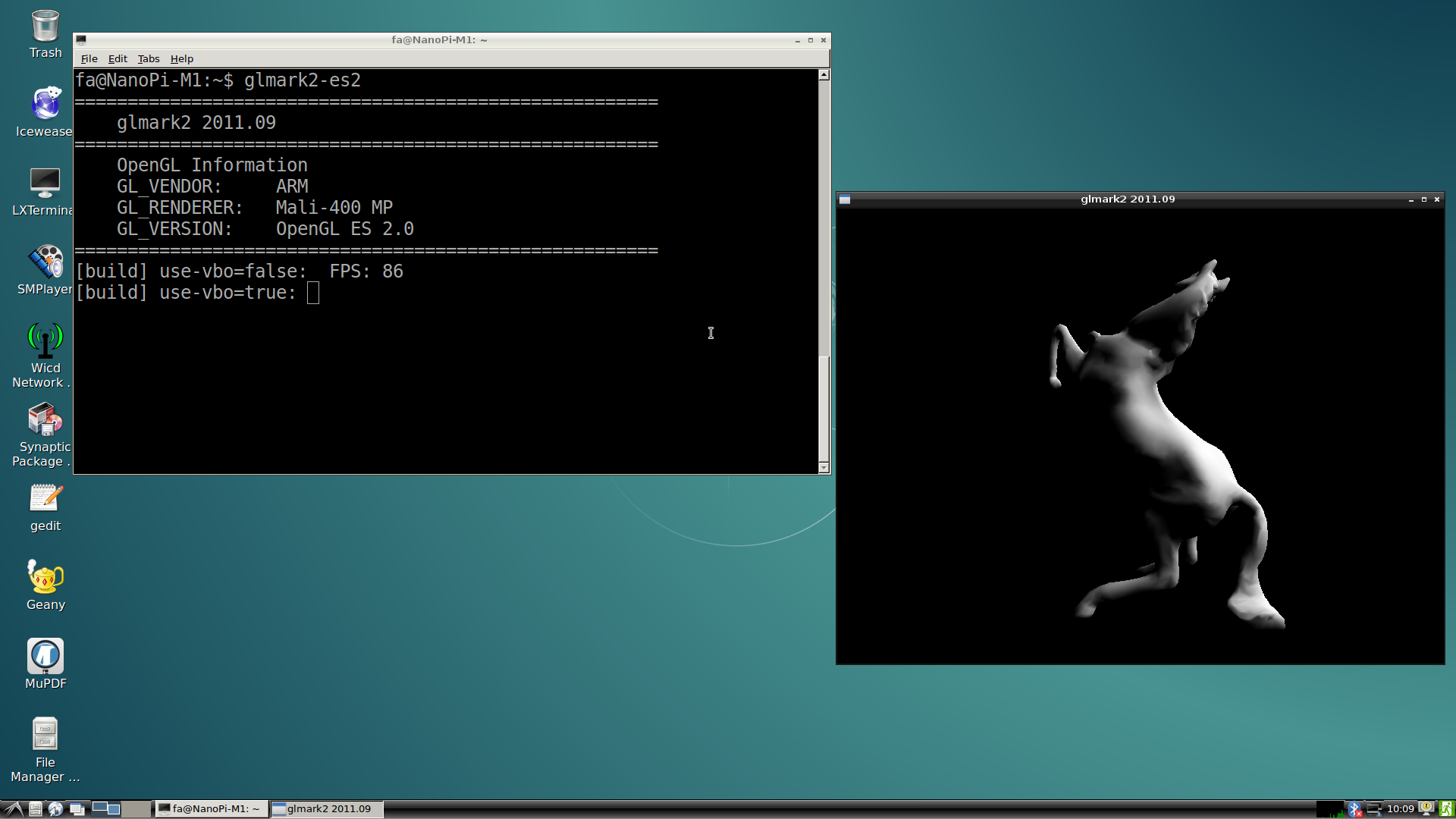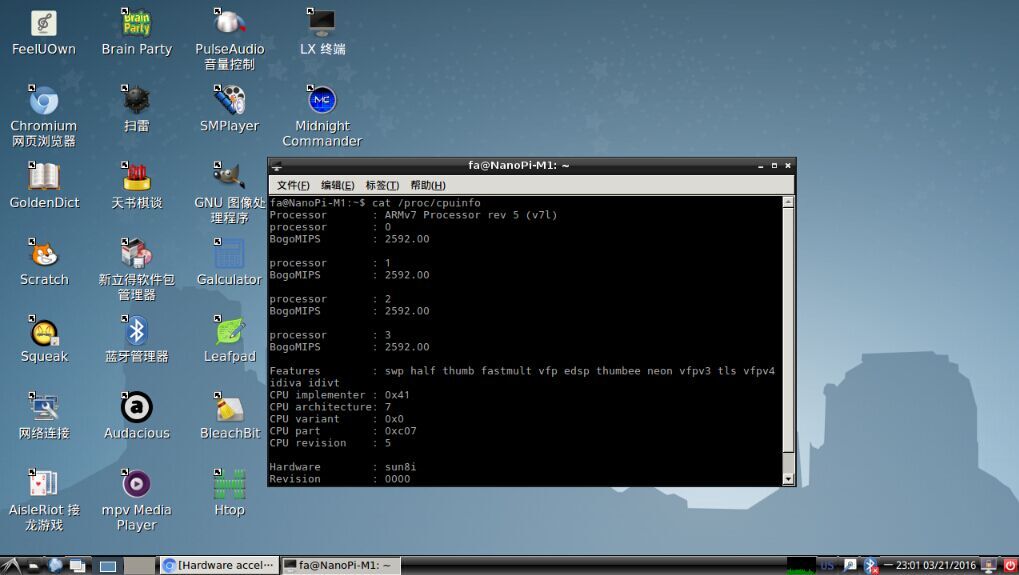NanoPi M1
Contents
1 Introduction
- The NanoPi M1 is an Allwinner H3 based ARM board designed and released by FriendlyARM for hobbyists, makers and electronic fans. It is only two thirds the size of the Raspberry Pi. It is open source. It works with Ubuntu MATE, Debian and etc.
- The NanoPi M1 uses the Allwinner H3 Soc. It integrates Ethernet, IR receiver, video/audio output and supports HDMI and AVOUT. It can be powered via the MicroUSB port
- In such a small board it still integrates rich interfaces and ports. Besides the popular HDMI, Ethernet, USB-Host, USB-OTG, DVP camera interface and AVOUT (audio and video) it has an onboard Microphone, IR receiver, a serial debug port and a Raspberry Pi compatible 40 pin GPIO pin header.
2 Features
- CPU: Allwinner H3, Quad-core Cortex-A7@1.2GHz
- GPU: Mali400MP2@600MHz,Supports OpenGL ES2.0
- DDR3 RAM: 512MB
- Connectivity: 10/100M Ethernet
- Audio: 3.5mm audio jack/Via HDMI
- Microphone: Onboard microphone
- IR Receiver: Onboard IR receiver
- USB Host:Type A, USB 2.0 x 3
- MicroSD Slot x 1
- MicroUSB: for data transmission and power input, OTG
- Video Output: HDMI 1.4 1080P, CVBS
- DVP Camera Interface: 24pin, 0.5mm pitch FPC seat
- Debug Serial Port: 4Pin, 2.54mm pitch pin header
- GPIO: 2.54mm spacing 40pin, compatible with Raspberry Pi's GPIO. It includes UART, SPI, I2C, IO etc
- User Key: Power LED x 1, Reset x 1
- PC Size: 64 x 50mm
- Power Supply: DC 5V/2A
- OS/Software: u-boot,Ubuntu MATE,Debian
3 Diagram, Layout and Dimension
3.1 Layout
- GPIO Pin Spec
Pin# Name Pin# Name 1 SYS_3.3V 2 VDD_5V 3 I2C0_SDA 4 VDD_5V 5 I2C0_SCL 6 GND 7 GPIOG11 8 UART1_TX/GPIOG6 9 GND 10 UART1_RX/GPIOG7 11 UART2_TX/GPIOA0 12 PWM1/GPIOA6 13 UART2_RTS/GPIOA2 14 GND 15 UART2_CTS/GPIOA3 16 UART1_RTS/GPIOG8 17 SYS_3.3V 18 UART1_CTS/GPIOG9 19 SPI0_MOSI/GPIOC0 20 GND 21 SIP0_MISO/GPIOC1 22 UART2_RX/GPIOA1 23 SPI0_CLK/GPIOC29 24 SPI0_CS/GPIOC3 25 GND 26 SPDIF-OUT/GPIOA17 27 I2C1_SDA/GPIOA19 28 I2C1_SCL/GPIOA18 29 GPIOA20 30 GND 31 GGPIOA21 32 GPIOA7 33 GPIOA8 34 GND 35 UART3_CTS/SPI1_MISO/GPIOA16 36 UART3_TX/SPI1_CS/GPIOA13 37 GPIOA9 38 UART3_RTS/SPI1_MOSI/GPIOA15 39 GND 40 UART3_RX/SPI1_CLK/GPIOA14
- Debug Port(UART0)
Pin# Name 1 GND 2 VDD_5V 3 UART_TXD0 4 UART_RXD0
- DVP Camera IF Pin Spec
Pin# Name Description 1, 2 SYS_3.3V 3.3V power output, to camera modules 7,9,13,15,24 GND Gound, 0V 3 I2C2_SCL I2C Clock Signal 4 I2C2_SDA I2C Data Signal 5 GPIOE15 Regular GPIO, control signals output to camera modules 6 GPIOE14 Regular GPIO, control signals output to camera modules 8 MCLK Clock signals output to camera modules 10 NC Not Connected 11 VSYNC vertical synchronization to CPU from camera modules 12 HREF/HSYNC HREF/HSYNC signal to CPU from camera modules 14 PCLK PCLK signal to CPU from camera modules 16-23 Data bit7-0 data signals
- Note:
- SYS_3.3V: 3.3V power output
- VDD_5V: 5V power input/output. When the external device’s power is greater than the MicroUSB’s the external device is charging the board otherwise the board powers the external device. The input range is 4.7V ~ 5.6V
- All pins are 3.3V and output current is 5mA. It can drive small loads. No IO pins can drive a load.
- For more details refer to the document: NanoPi-M1-1603-Schematic.pdf
3.2 Board Dimension
- For more details please refer to: pcb file in dxf
4 Get Started
4.1 Essentials You Need
Before starting to use your NanoPi M1 get the following items ready
- NanoPi M1
- microSD Card/TFCard: Class 10 or Above, minimum 8GB SDHC
- microUSB power. A 5V/2A power is a must
- HDMI monitor
- USB keyboard and mouse
- A host computer running Ubuntu 14.04 64 bit system
4.2 TF Cards We Tested
To make your NanoPi M1 boot and run fast we highly recommand you use a Class10 8GB SDHC TF card or a better one. The following cards are what we used in all our test cases presented here:
- SanDisk TF 8G Class10 Micro/SD TF card:
- SanDisk TF128G MicroSDXC TF 128G Class10 48MB/S:
- 川宇 8G C10 High Speed class10 micro SD card:
4.3 Make an Installation TF Card
4.3.1 Under Windows
Get the following files from here:[http://wiki.friendlyarm.com/wiki/nanopim1/download/ to download image files.
Image Files nanopi-m1-debian-sd4g.img.zip Debian Image Files Flash Utility: win32diskimager.rar Windows utility. Under Linux users can use "dd"
- Uncompress these files. Insert a TF card(at least 4G) into a Windows PC and run the win32diskimager utility as administrator. On the utility's main window select your TF card's drive, the wanted image file and click on "write" to start flashing the TF card.
- Insert this card into your NanoPi M1 and power on (with a 5V/2A power source). If the green LED is on and the blue LED is blinking this indicates your NanoPi M1 has successfully booted.
4.3.2 Get Image Files
Visit this link download link to download image files and the flashing utility:
Image Files nanopi-m1-debian-sd4g.img.zip Debian Image File sun8iw7p1_android_nanopi-h3_uart0.img.zip Android Image File Flash Utility: win32diskimager.rar Windows utility for flashing Debian image. Under Linux users can use "dd" PhoenixCard_V310.rar Windows utility for flashing Android image. Attention: the "dd" command under Linux doesn't work for flashing Android image HDDLLF.4.40.exe Windows utility for formatting a TF card
4.3.3 制作Debian系统TF卡
- 将固件nanopi-m1-debian-sd4g.img.zip和烧写工具win32diskimager.rar分别解压,在Windows下插入TF卡(限4G及以上的卡),以管理员身份运行 win32diskimager 工具,
在win32diskimager工具的界面上,选择你的TF卡盘符,选择系统固件,点击 Write 按钮烧写即可。
- 当制作完成TF卡后,拔出TF卡插入NanoPi M1的BOOT卡槽,上电启动(注意,这里需要5V/2A的供电),你可以看到绿灯常亮以及蓝灯闪烁,这时你已经成功启动 NanoPi M1。
4.3.4 制作Android系统TF卡
- 以管理员权限运行HDDLLF.4.40软件,并且格式化SD卡,格式化后把卡从电脑拔出来,再把卡插入电脑,使用Windows自带的格式化程序把SD卡格式化成FAT32格式,格式化后把卡拔出来;
- 将固件sun8iw7p1_android_nanopi-h3_uart0.img.zip和烧写工具PhoenixCard_V310.rar分别解压,在Windows下插入TF卡(限4G及以上的卡),以管理员身份运行 PhoenixCard_V310 工具, 在PhoenixCard_V310工具的界面上,选择你的TF卡盘符,镜像文件选择为Android系统固件,烧写模式选择卡启动,点击 烧录 按钮烧写即可。
- 当制作完成TF卡后,拔出TF卡插入NanoPi M1的BOOT卡槽,上电启动(注意,这里需要5V/2A的供电),这时你已经成功启动 NanoPi M1。
注:每次烧写Android系统时,必须先格式化TF卡。
5 Working with Debian
5.1 Extend TF Card's rootfs Section
We strongly recommend you to do this right after you have made an installation TF card since this will greatly enhance your M1's experience.
Insert your TF card into a host PC and run the following commands on your PC's terminal:
sudo umount /dev/sdx? sudo parted /dev/sdx unit % resizepart 2 100 unit MB print sudo resize2fs -f /dev/sdx2
Note: you need to replace "/dev/sdx" with the device name in your system
5.2 Run Debian
- Insert a TF card with Debian image files into your NanoPi M1, connect the NanoPi M1 to an HDMI monitor and a 5V/2A power source the NanoPi M1 will be automatically powered on. If you can see the blue LED flashing it means your board is working and you will see Debain being loaded on the HDMI monitor.
1)If you connect the NanoPi M1 to an HDMI monitor you need to use a USB mouse and a USB keyboard to operate.
2) If you want to do kernel development you need to use a serial communication board, ie a PSU-ONECOM board, which will allow you to operate the board via a serial terminal.
- Here is a setup where we connect a NanoPi M1 to a PC via the PSU-ONECOM and you can power on your M1 from either the PSU-ONECOM or M1's MicroUSB:
- The password for "root" is "fa".
5.3 Ethernet Connection
If the NanoPi M1 is connected to a network via Ethernet before it is powered on it will automatically obtain an IP after it is powered up. If it is not connected via Ethernet or its DHCP is not activated obtaining an IP will fail and system will hang on for about 15 to 60 seconds
- 1) Setup MAC Address
The NanoPi M1 by default doesn't have a valid MAC address. If the board connects a network successfully it will automatically generates a random MAC in "/etc/network/interfaces.d/eth0". Users can change it to a self-defined valid one:
vi /etc/network/interfaces.d/eth0
Here is the content of a sample configuration file:
auto eth0 allow-hotplug eth0 iface eth0 inet dhcp hwaddress 76:92:d4:85:f3:0f
The "hwaddress" specifies the MAC address. Here the "76:92:d4:85:f3:0f" is a random MAC. We suggest users change it to a valid one.
Note: when you reset the MAC please make sure your MAC meets IEEE's definition otherwise it will cause unexpected issues.
After you make your change, save, exit and reboot your board or run the following commands to restart the network:
systemctl restart networking
5.4 Login to Debian via VNC and SSH
If your NanoPi M1 is not connected to a display device you can login to your NanoPi M1 from a mobile phone. You need to download and install a "VNC Viewer" from here on a mobile phone and login to the NanoPi M1 via VNC. Its default password is "fa123456".
Here is a screenshot which shows how it looks like when users login to the NanoPi M1 from an iPhone via VNC:

You can login via "SSH -l root 192.168.8.1" and the default password for "root" is "fa". You need to replace "192.168.8.1" with your actual IP address.
5.5 HDMI Resolution
Our Debian system's HDMI resolution is set by a script.bin file in the root directory of the installation TF card's boot section. By default the resolution is 1080P60. There are multiple script.bin files under that directory for different resolutions. For example if you want to modify the resolution to 720P60 you can use the script-720p-60.bin file to replace the existing one by using the following command:
# in TF card boot partition cp script/script-720p-60.bin ./script.bin
5.6 HDMI Audio Output
Our Debian system's default audio output is the 3.5mm audio jack. You can turn on the HDMI audio by editting the /etc/asound.conf file:
pcm.!default { type hw card 1 device 0 } ctl.!default { type hw card 1 }
card 0 points to the 3.5mm audio jack and card 1 points to the HDMI audio. You need to save your changes and reboot your system to make your changes take effect.
5.7 Test GPU
After Debian loads please login from a terminal and run "glmark2-es2":
glmark2-es2
5.8 Test VPU
Visit this link download link to download files
After Debian is loaded login from a terminal and run "mplayer":
mplayer -vo vdpau -vc ffmpeg12vdpau,ffh264vdpau, ./big_buck_bunny_1080p_H264_AAC_25fps_7200K.MP4
In our test it could play 1080P video fluently.
6 Make Your Own Debian
Visit this link download to get the source code, uncompress it and a lihee directory will be generated. Or you can get it from our github:
git clone https://github.com/friendlyarm/h3_lichee.git lichee
After you get the source code enter the lichee directory:
cd lichee6.1 Compile Source Code
Compile the whole source code packages including U-boot, Linux Kernel and Modules. You must do it on a host computer running a 64-bit Linux OS. The following cases were tested on Ubuntu-14.04 LTS-64bit:
sudo apt-get install gawk git gnupg flex bison gperf build-essential \ zip curl libc6-dev libncurses5-dev:i386 x11proto-core-dev \ libx11-dev:i386 libreadline6-dev:i386 libgl1-mesa-glx:i386 \ libgl1-mesa-dev g++-multilib mingw32 tofrodos \ python-markdown libxml2-utils xsltproc zlib1g-dev:i386
Run the following command to compile the whole package:
./build.sh -p sun8iw7p1 -b nanopi-h3
After this compilation succeeds a u-boot, Linux kernel and kernel modules will be generated
Note: the lichee directory contains a cross-compiler we have setup. When the build.sh script runs it will automatically call this cross-compiler.
6.2 Flash Image to TF Card
Run the following command to flash U-boot, Linux Kernel and script.bin to your TF card:
./burn_into_sd.sh /dev/sdx
Note: you need to replace "/dev/sdx" with the device name in your system. This script flashes U-Boot to your TF card and copies uImage and script.bin to your TF card's boot section.
6.3 Compile U-boot
./build.sh -p sun8iw7p1 -b nanopi-h3 -m uboot
After a u-boot executable is generated some extra patches need to be patched to it. Run "./gen_script.sh" to patch this executable.
If you want to manually patch the executable refer to H3_Manual_build_howto
6.4 Compile Linux Kernel
./build.sh -p sun8iw7p1 -b nanopi-h3 -m kernel
After the compilation is done a uImage and its kernel modules will be generated under "linux-3.4/output".
6.5 Clean Source Code
./build.sh -p sun8iw7p1 -b nanopi-h3 -m clean
7 Make Your Own Android
8 More OS Support
8.1 Ubuntu-Core
Ubuntu-Core is a basic verson which has support for Ethernet and SSH.
FriendlyARM doesn't provide technical support for it.
- Go to this link download link to download the image files
- Uncompress it and flash the image file to a TF card with win32diskimager under Windows
- After it is done you can boot your NanoPi M1 with this card
- Login name: "root" or "fa", Password: fa
8.2 Ubuntu-MATE
Ubuntu-Mate is a Ubuntu variant and its GUI is Mate-desktop. You can login via SSH when you connect a NanoPi M1 to an HDMI
FriendlyARM doesn't provide technical support for it
- Go to this link download link to download the image files
- Uncompress it and flash the image file to a TF card with win32diskimager under Windows
- After it is done you can boot your NanoPi M1 with this card
- Login name: "root" or "fa", Password: fa
8.3 Debian8(Jacer)
Debian8(Jacer)系统是网友爱好者“Jacer”基于Debian8系统移植并支持,使用的桌面环境是Debian8,此系统对中文支持较好,界面简洁易用,需配合HDMI使用,可通过ssh登录。
由于该系统由第三方爱好者移植提供,友善官方仅提供给进阶爱好者交流使用,不对该系统提供专业技术支持。
- 下载系统固件Debian8(unofficial-Jacer).rar:点击下载
- 将文件解压后得到系统固件,在Windows下使用友善官方提供 win32diskimager 工具烧写即可。
- 烧写完成后,将TF卡插入NanoPi M1,上电即可体验。
- 登录账号:fa ; 登录密码:fa
注:Debian8(Jacer)系统接HDMI桌面环境登录时,不建议使用root权限登录,否则界面为黑色,无法显示完整操作界面;
Debian8(Jacer)系统集成了GPU驱动和H264 H265硬解,分辨率默认使用的是720p;如果需要用1080P的分辨率显示,则需要将/boot分区的script.fex里面的HDMI MODE=后面改成相应的数字然后转换为script.bin,修改方法可以参考里面的文件h3disp.sh;
Debian8(Jacer)系统支持的无线网卡型号为 :8192cu、 8188cus 、8188eu、 rt3070。
Debian8(Jacer)支持:
- 1.Mali400 GPU驱动
- 2.mpv硬解H264 H265
- 3.最新Chromium浏览器支持flash视频
- 4.支持网易云音乐feeluown
- 5.纸牌 扫雷 象棋游戏
- 6.retroarch游戏模拟器
- 7.为512MB内存增加128mb交换分区虚拟内存
- 8.四核动态调整频率
- 9.aria2下载器
- 10.samba服务
- 11.8192cu/8188cus/8188eu/rt3070/rt2800/rt5370无线网卡支持
- 12.GIMP图形编辑软件
- 13.SSH连接
- 14.xrdp和vnc远程桌面服务
- 15.HTML5多媒体播放
- 16.goldendict词典
- 17.audacious音乐播放器
- 18.pulseaudio音量调整
- 19.USB蓝牙支持
9 Resources
- Schematic NanoPi-M1-1603-Schematic.pdf
- Dimensional Diagram pcb file in dxf
- Allwinner H3 datasheet Allwinner_H3_Datasheet_V1.2.pdf
10 Update Log
10.1 March-22-2016
- Released English Version
10.2 March-29-2016
- Corrected expression errors
